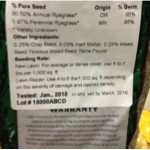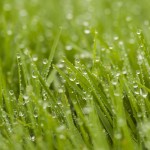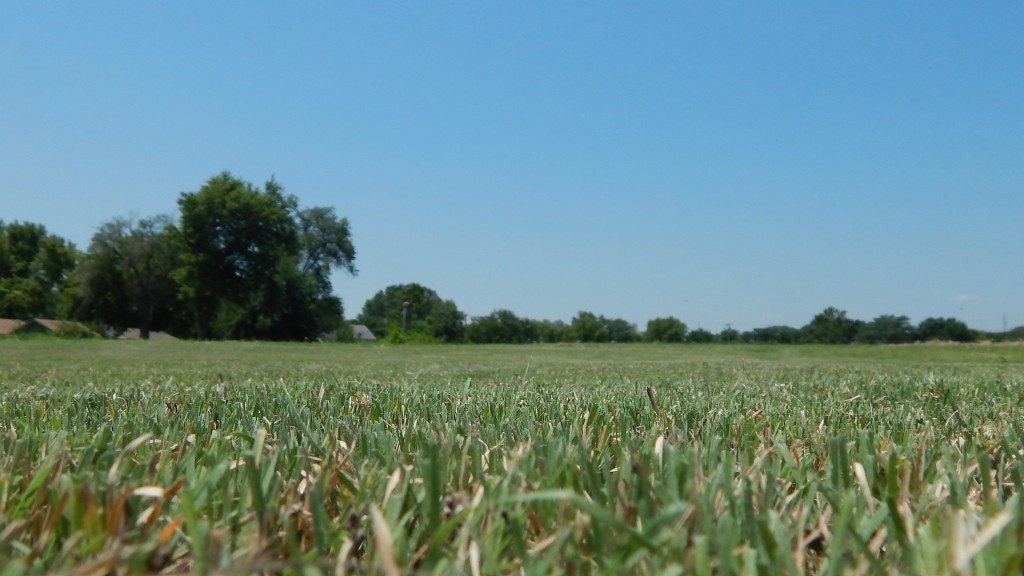
Dr. Ross Braun presents an overview of the benefits of September seeding in this 2-Minute K-State Turf Extension Video. CLICK HERE!

Dr. Ross Braun presents an overview of the benefits of September seeding in this 2-Minute K-State Turf Extension Video. CLICK HERE!
By Daniele McFadden (recent M.S. graduate at K-State)
With spring in full swing many of you are taking advantage of the warm soil temperatures and overseeding turf areas. Often times we can mistakenly coincide our spring-time herbicide applications with seeding cool-season turf. So, are your new seedlings going to mature and develop if this happens? Research was done over the last two years to evaluate how several herbicides affect the emergence and growth of tall fescue and Kentucky bluegrass when seeded after application. Following are some takeaways from these experiments.
The good:
The bad:
The ugly:
Bottom line – reading the label to learn how soon seeding can be done after herbicide application is critical. Labels on some of these products indicate that seeding should be done after a longer interval has passed after application compared to what was observed as required in this research. Seeding guidelines on labels must be followed; that said, research results from this project provide useful information to herbicide manufacturers and turf managers who may unknowingly seed into herbicide-treated areas.

These research results will soon appear in greater detail in K-State’s 2021 Turfgrass Research Research Report.
***Mention of trade names or commercial products in this article is solely for identification purposes and does not imply recommendation or endorsement, nor is criticism implied of similar products not mentioned by Kansas State University.***
(By Jared Hoyle, KSU Turfgrass Research and Extension)
It is that time of year again to start working on your cool-season lawn. To try and cover it all, I have listed a couple posts from the past that can help you get that lawn into shape. I also have added a list of publications. Enjoy!
Time to fertilize cool-season turfgrass
https://blogs.k-state.edu/turf/time-to-fertilize-cool-season-turfgrass/
Monthly calendar for cool-season lawns for the rest of the year
https://blogs.k-state.edu/turf/monthly-calendar-for-cool-season-lawns-for-the-rest-of-2017/
Power raking or core aeration – That is the question!
https://blogs.k-state.edu/turf/power-raking-or-core-aeration-that-is-the-question/
The art of knowing your seed label
https://blogs.k-state.edu/turf/the-art-of-knowing-your-seed-label/
For seeding success, pay attention to other crop on the seed label
https://blogs.k-state.edu/turf/for-seeding-success-pay-attention-to-other-crop-on-the-seed-label/
Publications
Lawn Fertilizing Guide – https://www.bookstore.ksre.ksu.edu/Item.aspx?catId=545&pubId=10639
Recycling your grass clippings – https://www.bookstore.ksre.ksu.edu/Item.aspx?catId=545&pubId=701
Mowing your lawn – https://www.bookstore.ksre.ksu.edu/Item.aspx?catId=545&pubId=615
Tall Fescue Lawns – https://www.bookstore.ksre.ksu.edu/Item.aspx?catId=545&pubId=1460
Watering New Lawns – https://www.bookstore.ksre.ksu.edu/Item.aspx?catId=545&pubId=1337
Planting a Home Lawn – https://www.bookstore.ksre.ksu.edu/Item.aspx?catId=545&pubId=595
Aerating Your Lawn – https://www.bookstore.ksre.ksu.edu/Item.aspx?catId=545&pubId=713
Kentucky Bluegrass Lawns – https://www.bookstore.ksre.ksu.edu/Item.aspx?catId=545&pubId=713
Check out the KSRE Bookstore for more publications – https://www.bookstore.ksre.ksu.edu/Category.aspx?id=528&catId=545
(By Jared Hoyle, KSU Turfgrass Research and Extension)
After finding the article on grey leaf spot I found a couple more articles that I wanted to repost due to the time of the year it is.
One is on determining if you need are going to conduct power raking or core aeration this fall?
https://blogs.k-state.edu/turf/power-raking-or-core-aeration-that-is-the-question/
The others were on selecting the right grass seed!
https://blogs.k-state.edu/turf/for-seeding-success-pay-attention-to-other-crop-on-the-seed-label/
https://blogs.k-state.edu/turf/the-art-of-knowing-your-seed-label/
***Mention of trade names or commercial products in this article is solely for identification purposes and does not imply recommendation or endorsement, nor is criticism implied of similar products not mentioned by Kansas State University.***
Don’t forget to follow me on twitter @KSUTurf.
Also, visit our facebook page www.facebook.com/KSUTurf
(By Jared Hoyle and Ward Upham, KSU Research and Extension)
When we talk about cool-season turfgrass seeding timing I always think the fall. Well all around town I keep seeing more and more people seeding their lawn this spring. I don’t want to say you are wasting your time because there are a couple reasons that you might need or have to seed in the spring but most success is achieved if seeding cool-season turfgrass in the fall.
There are several reasons Kentucky bluegrass and tall fescue lawns are better seeded in the fall than in the spring.
These include:

If an area needs to be established in the spring, sodding is much more likely to be successful than seeding. Sodding provides stronger, more mature plants that are better able to withstand stress and prevent weed invasion.
(By Jared Hoyle; KSU Turfgrass Research and Extension)
All summer we have been trying to keep our cool-season turfgrass alive. Now is the time if we had some die because of heat or drought to build a healthy turfgrass for the winter and next years hot summer. There are many things to talk about so we will list them below.
First all – FERTILITY. I talked about this awhile ago in a previous blog post so I will just list that link and you can go back and ready it.
Next – SEEDING. This is from Ward Upham’s (KSU Research and Extension) last news letter but wanted to make sure it was put in the fall lawn care blog. He really explains the seeding process and information pertaining to seeding in this article.
“September is the best month to reseed cool-season lawns such as tall fescue and Kentucky bluegrass. However, you can get by with an early to mid-October planting for tall fescue. October 15 is generally considered the last day for safely planting or overseeding a tall fescue lawn in the fall. If you do attempt a late seeding, take special care not to allow plants to dry out. Anything that slows growth will make it less likely that plants will mature enough to survive the winter.
Seedings done after the cut-off date can be successful, but the success rate goes down the later the planting date. Late plantings that fail are usually not killed by cold temperatures but rather desiccation. The freezing and thawing of soils heave poorly rooted grass plants out of the ground, which then dry and die. Keeping plants watered will help maximize root growth before freezing weather arrives. (Ward Upham)”
So what I am getting out of Ward’s article is that you are going to have a better success for seeding if you do it now and not wait until later.
There is lots more information in the Tall Fescue publication from the KSRE bookstore.
http://www.bookstore.ksre.ksu.edu/Item.aspx?catId=545&pubId=1460
Also, if you want to know what varieties work well in Kansas. Check out the Tall Fescue Varieties for Kansas Publication. (New NTEP data has not be used to update the varieties. – Coming soon!)
http://www.bookstore.ksre.ksu.edu/Item.aspx?catId=545&pubId=19180
This will get everyone started. There is lots more information out there about cool season turfgrass management at the KSU Turfgrass Website. Check it out at http://www.k-state.edu/turf/
(By Evan Alderman, KSU Turfgrass MS Student; Ross Braun, KSU Turfgrass PhD Student; and Jared Hoyle, KSU Turfgrass Research and Extension)
Do you enjoy having a nice green lawn, but didn’t have time to get your fall seeding done? Don’t fret, there is still time. Although the optimal time of year to seed cool season grass species is during the fall months, there is still time for you to get a great looking lawn for this summer. Now before you go to your local garden supply store and pick up some seed, there are several things you should take into account before making your purchase. The art of knowing your seed label begins now.
Turfgrass Species and Cultivar
 So you walk into your local garden supply store and you look at all of your options for potential seed you can use and you say to yourself “I really want a lush green lawn fast”. So you pick up a bag that says something along the lines of “quick establishment”, since that is what you want. Although this bag of seed sounds like a great option, you probably should check out the seed label before making this purchase. In the image is a picture of a seed bag with those claims. As you can see this bag contains 90.50% annual ryegrass (Lolium multiflorum) and only 5.97% perennial ryegrass (Lolium perenne). Now as a turfgrass scientist I can assure you that you may have a great looking lawn temporarily, but annual ryegrass should not be a long term solution. Which is why Rule #1 for the art of knowing your seed label is know what turfgrass species performs best in your area. For much of the state of Kansas, tall fescue (Lolium arundinacea) is the predominant species in most home lawns. Tall fescue is able to handle most of the drought conditions that Kansas likely endures.
So you walk into your local garden supply store and you look at all of your options for potential seed you can use and you say to yourself “I really want a lush green lawn fast”. So you pick up a bag that says something along the lines of “quick establishment”, since that is what you want. Although this bag of seed sounds like a great option, you probably should check out the seed label before making this purchase. In the image is a picture of a seed bag with those claims. As you can see this bag contains 90.50% annual ryegrass (Lolium multiflorum) and only 5.97% perennial ryegrass (Lolium perenne). Now as a turfgrass scientist I can assure you that you may have a great looking lawn temporarily, but annual ryegrass should not be a long term solution. Which is why Rule #1 for the art of knowing your seed label is know what turfgrass species performs best in your area. For much of the state of Kansas, tall fescue (Lolium arundinacea) is the predominant species in most home lawns. Tall fescue is able to handle most of the drought conditions that Kansas likely endures.
Rule #2 for the art of knowing your seed labels is also knowing which species cultivars grow best in your area of the country. One of the best options for knowing which turfgrass cultivars perform best in your area is the National Turfgrass Evaluation Program (www.ntep.org). On their website, there is data available for homeowners to look at from many different university studies involving different turfgrass species and cultivars. This information will help you make an informed decision on what turfgrass species and cultivar will work best for you, this is a step in the right direction for achieving that lush green lawn you are wanting.
Other Seed Label Information
Although some of the most important information on the seed label is the turfgrass species and variety, there are several other pieces of information on the label that can be helpful. Rule #3, look at the percent germination for all turfgrass species on the seed label. Just because that type of seed is on the label doesn’t mean all of it will germinate. Thus it is important to look at the germination rate, and chose a bag of seed that has a high germination percentage. Rule #4, although the bag of turf seed you are going to by mostly contains grass seed, bags of seed can also can weed seed. It is very important to look at the percentage of weed seed in your bag of seed, if that percentage is high, I would probably pass on that bag and look for another one with a lower percent of weed seed. If a seed label has 0.5% weed seed then that equals approximately 12 to 16 weeds being planted per square foot. A seed label with <0.01 weed seed is good but 0% is best. This also applies to the “other crop” section of the label. Lastly, Rule #5, consider the seed testing date on the seed label. As with anything, turfgrass seed can get old, this will highly effect the germination percentage from that bag of seed. It is recommended to use newer seed and avoid anything over one year past the testing date.
Utilizing these five rules will help you make an informed decision for planting a lush green lawn this spring.
Always remember to READ THE LABEL for the correct rate, turfgrass tolerance, and specific instructions before application!!!
***Mention of trade names or commercial products in this article is solely for identification purposes and does not imply recommendation or endorsement, nor is criticism implied of similar products not mentioned by Kansas State University.***
Don’t forget to follow me on twitter @KSUTurf.
Also, visit our facebook page www.facebook.com/KSUTurf
(By Ward Upham and Jared Hoyle, KSU Research and Extension)
 September is the best month to reseed cool-season lawns such as tall fescue and Kentucky bluegrass. However, you can get by with an early to mid-October planting for tall fescue. October 15 is generally considered the last day for safely planting or overseeding a tall fescue lawn in the fall. If you do attempt a late seeding, take special care not to allow plants to dry out. Anything that slows growth will make it less likely that plants will mature enough to survive the winter.
September is the best month to reseed cool-season lawns such as tall fescue and Kentucky bluegrass. However, you can get by with an early to mid-October planting for tall fescue. October 15 is generally considered the last day for safely planting or overseeding a tall fescue lawn in the fall. If you do attempt a late seeding, take special care not to allow plants to dry out. Anything that slows growth will make it less likely that plants will mature enough to survive the winter.
Seedings done after the cut-off date can be successful, but the success rate goes down the later the planting date. Late plantings that fail are usually not killed by cold temperatures but rather desiccation. The freezing and thawing of soils heave poorly rooted grass plants out of the ground, which then dry and die. Keeping plants watered will help maximize root growth before freezing weather arrives.
(by Ward Upham and Jared Hoyle, KSU Research and Extension)
Though several cool-season grasses are grown in Kansas, tall fescue is considered the best adapted and is recommended for home lawns. The cultivar K-31 is the old standby and has been used for years. However, there is a myriad of newer cultivars that have improved color, density and a finer leaf texture. Most of these newer varieties are very close to one another in quality. Each year the National Turfgrass Evaluation Trial rates tall fescue varieties for color, greenup, quality and texture. Quality ratings are taken once a month from March through October. K-31 consistently rates at the bottom. The recommended cultivars were 3rd Millennium, Braveheart, Bullseye, Catalyst, Cochise, Corona, Escalade, Faith, Falcon V, Firecracker, Firenza, Jamboree, LS 1200, Monet, Mustang, Raptor II, Rhambler SRP, RK5, Shenandoah III, Shenandoah Elite, Sidewinder, Spyder LS, Talladega, Turbo and Wolfpack II. There are a number of other cultivars that did not make this list but should do well in Kansas. Go to http://ntep.org/data/tf06/tf06_12-10f/tf0612ft04.txt . Any variety with a mean rating of 6.0 or above should be fine. K-31 has a rating of 4.1. Keep in mind that mixes of several varieties may allow you to take advantage of differing strengths. It is not necessary for mixes to contain only the varieties mentioned above. Though K-31 may still be a good choice for large, open areas, the new cultivars will give better performance for those who desire a high-quality turf.
Though Kentucky bluegrass is not as heat and drought tolerant as tall fescue and the warm-season grasses, it is commonly used in northeastern Kansas, where there is sufficient annual rainfall. It is also grown under irrigation in northwestern Kansas where the higher elevation allows for cooler summer night temperatures. The following cultivars have performed well compared to other bluegrasses in this region. Use this list as a guide. Omission does not necessarily mean that a cultivar will not perform well. Recommended cultivars for high-quality lawns, where visual appearance is the prime concern, include Alexa II, Aura, Award, Bewitched, Barrister, Belissimo, Beyond, Diva, Everest, Everglade, Excursion, Ginney II, Granite, Impact, Midnight, NuChicago, NuGlade, NuDestiny, Rhapsody, Rhythm, Rugby, Skye, Solar Eclipse, STR 2485, Sudden Impact, Washington and Zifandel. Such lawns should receive 4 to 5 pounds nitrogen per 1,000 square feet per year and would typically be irrigated during dry periods to prevent drought stress. Cultivars that do relatively well under a low-maintenance program with limited watering often differ from those that do well under higher inputs. Good choices for low maintenance include Baron, Baronie, Caliber, Canterbury, Dragon, Eagleton, Envicta, Kenblue, North Star, and South Dakota. Instead of the 4 to 5 pounds of nitrogen per 1,000 square feet per year, low-maintenance program would include 1 to 2 pounds of nitrogen per 1,000 square feet per year. Obviously, a low-input lawn will not be as attractive as a higher-input lawn, but you can expect the cultivars listed above to look fairly good in the spring and fall, while going dormant in the summer.
(By Jake Reeves and Jared Hoyle, KSU Turfgrass Research and Extension)

Water restrictions and increased interest in sustainability are driving many golf course superintendents to consider new ways to save. Ironically, one of the best new fits for saving in Kansas is one of the oldest ways around: buffalograss. Buffalograss (Buchloe dactyloides) is actually the only widely used turfgrass native to North America. Many of the recent cultivars (Sharp’s Improved II, Bowie) grow denser and greener than their predecessors while not sacrificing their drought/cold tolerance, disease resistance, and other great characteristics. Traffic intolerance is one of the largest concerns for many superintendents, but a little traffic management can go a long way especially if coupled with cart paths. While not a perfect fit for every situation, buffalograss requires very little water, less mowing, and minimal nitrogen input to achieve an acceptable stand.
 It is these characteristics that have many courses considering replacing their tall fescue roughs with buffalograss. Once established, the courses could divert the money and time previously spent on their roughs to tees, fairways, and greens, ultimately rewarding a well-played round.
It is these characteristics that have many courses considering replacing their tall fescue roughs with buffalograss. Once established, the courses could divert the money and time previously spent on their roughs to tees, fairways, and greens, ultimately rewarding a well-played round.
The end product is exciting for many superintendents, as their water bills would shrink. However, going through long periods of closing the course for renovations isn’t appealing to already cash-strapped courses. Minimizing downtime and maximizing germination success with buffalograss seeding is a must if a course wanted to reduce the financial impact of the process.
We wanted to look at the most effective form of renovation from tall fescue roughs to buffalograss roughs without tilling the soil. This was to allow play to continue as long as possible on the course and keeping the renovation process very feasible for most courses. Examining 3 different mowing heights and 4 different cultivation practices, our results will provide the most time and cost effective method for end users.
 We are comparing a zero cultivation practice, aerification(2x), verticutting(2x), and slit seeding(2x @ 2lbs/M each pass) against the 3 mowing heights (2.5”, 1.75”, 1.25”). All cultivation practices except for slit-seeding were broadcast with Sharp’s Improved II buffalograss seed at 4 lbs/1000 ft2. Traditionally, it is recommended that buffalograss seed be soaked for 3 days, changing the water every day, to encourage a quick germination upon seeding. However, we did not soak the seed, believing the process not to be practical if a course was truly reseeding all of their rough.
We are comparing a zero cultivation practice, aerification(2x), verticutting(2x), and slit seeding(2x @ 2lbs/M each pass) against the 3 mowing heights (2.5”, 1.75”, 1.25”). All cultivation practices except for slit-seeding were broadcast with Sharp’s Improved II buffalograss seed at 4 lbs/1000 ft2. Traditionally, it is recommended that buffalograss seed be soaked for 3 days, changing the water every day, to encourage a quick germination upon seeding. However, we did not soak the seed, believing the process not to be practical if a course was truly reseeding all of their rough.
Our results to date have shown that slit-seeding was the most successful method by far with aerification, verticutting, and zero cultivation decreasing in effectiveness in that order. Slit-seeding mowed at 1.25” and 1.75” reached 100% cover 6 weeks after seeding (WAS) with minimal weed encroachment. Ultimately, mowing height has had no effect except for a very slight lag in plots mowed at 2.5” compared to the two lowers heights. We hope to continue looking at fescue removal and buffalograss seeding in order to shorten the green cover loss experienced in the renovation process.